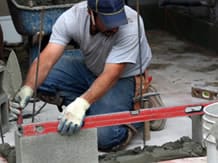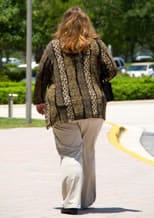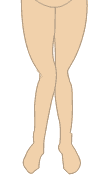Certain situations or risk behaviours can precipitate the onset and/or worsening of osteoarthritis. It is important to know them because it is possible to act effectively against some of them.
Repeated microtrauma

Microscopic lesions, due to too much stress, can cause trauma to the joints and the onset of osteoarthritis.
This is the case in certain occupations in which people are subjected to mechanical vibration and repeated shocks (e.g. users of pneumatic drills, drivers of construction machinery, etc.), or perform repetitive movements such as data entry operators, pianists, seamstresses, etc. Cases of knee osteoarthritis also frequently occur in people working in a kneeling position (e.g. tile layers).
Joint trauma
Joint fractures and severe sprains, especially those affecting the cruciate ligament of the knee, are often the cause of osteoarthritis whose symptoms first appear ten years later. Excessive practice of a sport is a cause of early osteoarthritis, mainly because of repeated trauma (e.g. osteoarthritis of the hip in footballers).
Complete removal of a meniscus of the knee (meniscectomy) is the cause of osteoarthritis occurring from 10 to 20 years later in one out of two cases. That is why it is necessary to be as sparring as possible when proposing surgery on a meniscus.
Metabolic diseases
Abnormalities of certain metabolisms can lead to the deposit of microscopic crystals in the joints. This is the case of gout (made up of uric acid crystals) and chondrocalcinosis (calcium phosphate crystals).
It is the repetition of inflammatory flare-ups triggered by these deposits that promotes the development of osteoarthritis in the joint in question.
Other much rarer metabolic diseases may also be accompanied by osteoarthritis such as haemochromatosis, characterised by an iron overload in the body or Wilson's disease due to a copper overload.
Excess weight

Obesity is not only a predisposing factor for the onset of osteoarthritis of the knee but also an aggravating factor.
It also promotes the development of digital osteoarthritis by mechanisms that are not yet fully known.
There is an equation allowing you to calculate your body mass index, for which normal value is between 20 and 25. BMI equals a person's weight in kilograms divided by their height in metres squared.
For example, the BMI of a person weighing 83 kg and measuring 1.75 metres is equal to:
83 divided by (1.75)²
hence: 83 ÷ (1.752)2 = 83 ÷ 3.0625 = 27.10
By definition, a person with a BMI above 25 is considered to be overweight.
We talk about overweight when the BMI is between 25 and 29.9 and obesity when the BMI is equal to or greater than 30.
To find out if you are "at risk", calculate your theoretical ideal weight >> Click here <<
The menopause
In women, osteoarthritis is more common after the menopause.
It is thought that sex hormones may be involved, but currently no hormonal treatment administered after the menopause has shown a protective effect against osteoarthritis.
Heredity
Heredity seems to intervene in osteoarthritis. Numerous epidemiological studies have established that there is a family character for osteoarthritis of the fingers or knees. Hence, a woman risks having osteoarthritis of the fingers when her mother or maternal or paternal aunt suffers from it.
Genetic research has shown, in some families, abnormal genes involved in the manufacture of cartilage components.
Disorders of the architecture of the limbs
Some abnormalities of the skeleton and/or the limbs may be the cause of osteoarthritis.
Hence, congenital dislocation of the hip must be systematically sought.

Deformation of the axis of the leg may be a factor leading to osteoarthritis: this is the case in "genu varum", a common deformity in which both knees deviate from one another.
The displacement of the centre of gravity inside the knee increases the internal pressure in the cartilage of the joint between the femur and the tibia and can therefore promote the occurrence of osteoarthritis at this site.

Conversely, "genu valgum"is the cause of knees that are closer to one another while the ankles are further apart.



















